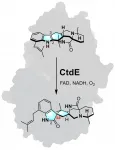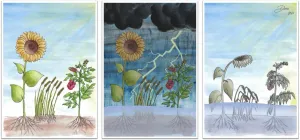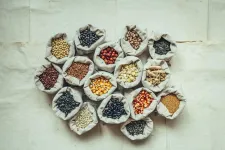(Press-News.org) When traffic is clogged at a downtown intersection, there may be a way to reduce some of the congestion: Eliminate a few left turns.
According to Vikash Gayah, associate professor of civil engineering at Penn State, well-placed left-turn restrictions in certain busy intersections could loosen many of the bottlenecks that hamper traffic efficiency. He recently created a new method that could help cities identify where to restrict these turns to improve overall traffic flow.
"We have all experienced that feeling of getting stuck waiting to make a left turn," Gayah said. "And if you allow these turns to have their own green arrow, you have to stop all other vehicles, making the intersection less productive. Left turns are also where you find the most severe crashes, especially with pedestrians. Our idea is to get rid of these turns when we can to create safer and more efficient intersections."
By selectively restricting left turns, but not banning them entirely, drivers may simply need to find alternate routes to their destinations in certain areas, Gayah said. Some may be required to travel a few extra blocks, but Gayah believes more efficient traffic flow through busy intersections offsets the additional distance.
For urban planners, he added, determining where to place the restrictions is a balancing act between intersection productivity and increased travel lengths. With so many restriction possibilities to consider, finding the most efficient layout may prove difficult.
"For example, if you just have 16 intersections to consider, each with a choice to allow or not allow left turns, that is already 65,000 different configurations," Gayah said. "It gets even more complicated when you consider that traffic flows from one intersection to the next, so decisions depend on one another. There ends up being so many possible answers that we can never find the best one."
Gayah's new method relies on heuristic algorithms, which use shortcuts to find solutions that nearly approach, but are not guaranteed to be, an optimal outcome.
"We make a guess, we learn from that guess, and then we make better guesses," he said. "Over time, we can get really, really close to the best answer."
In a study published in Transportation Research Record, Gayah combined two existing heuristic algorithms to create a new hybrid approach. The first, a population-based incremental learning (PBIL) algorithm, randomly sampled potential configurations and recognized the patterns of high-performing options. Next, a Bayesian optimization algorithm analyzed this new set of high performers to identify how restrictions were affecting traffic at adjacent intersections. Bayesian optimization combines initial information about the problem and updates it over time as new information is learned to attain a solution which is close to, but not necessarily perfect. The algorithm then applied this knowledge of traffic dynamics to find more efficient solutions.
"Instead of starting the Bayesian optimization with a random guess, we fed it with the best guesses from the PBIL," Gayah said. "The first method creates the starting point, and the second refines it."
Gayah tested the hybrid method through a simulated, square network in a variety of scenarios, finding that all three methods -- PBIL, Bayesian optimization and hybrid -- identified configurations that led to more efficient traffic patterns than a layout with zero restrictions. However, in simulations with more realistic settings, the hybrid method proved to be the most effective.
According to Gayah, the most efficient configurations tended to ban left turns in the middle of the city and allowed them more often on the periphery. While the method was applied to a generalized network, the results can be used as a starting point for real-world traffic patterns with the algorithms being customizable on a city-by-city basis.
"The grid network is the most generalizable and not specific to any city," Gayah said. "I cannot take the best configuration for New York and apply it to San Francisco, but this generalized approach could be configured for any network with a little bit of coding."
INFORMATION:
Murat Bayrak, postdoctoral researcher in the Department of Civil Engineering at Aalto University, also contributed to the project.
A National Science Foundation CAREER award supported this research.
Using simple blood tests could help researchers identify children who have been misidentified as having severe malaria, according to a study published today in eLife.
Researchers are working to develop better ways to treat severe malaria, which kills about 400,000 children in Africa each year. The discovery could help expedite such research by helping them more accurately identify children with severe malaria. It also reinforces the importance of the World Health Organization's recommendation that all children being treated for severe malaria also receive antibiotics to ensure any misdiagnosed children receive life-saving care.
Diagnosing severe malaria in children in Africa is challenging because the ...
HOUSTON - (July 6, 2021) - A small fungal enzyme could play a significant role in simplifying the development and manufacture of drugs, according to Rice University scientists.
The Rice lab of chemical and biomolecular engineer Xue Sherry Gao and collaborators isolated a biocatalyst known as CtdE after identifying it as the natural mechanism that controls the chirality -- the left- or right-handedness -- of compounds produced by the native fungal host.
The open-access study appears in Nature Communications.
Two chiral things are, like hands, alike in structure but cannot perfectly ...
Researchers from HSE University and Max Planck Institute for Human Cognitive and Brain Sciences have discovered how the theta rhythm of the brain and the gender differences in attitudes to risk are linked. In an article published in the journal Frontiers in Neuroscience, the researchers addressed which processes can be explained by knowing this connection. https://www.frontiersin.org/articles/10.3389/fnins.2021.608699/full
By transmitting signals, the brain's neurons generate electromagnetic fields. The multiplicity of neurons makes these fields strong enough to be recorded on the surface of the head using magneto- and electroencephalography techniques. ...
The future of cod stocks in the North Sea and the Barents Sea may be much easier to predict than before. This is the result of an international research project led by the Helmholtz-Zentrum Hereon and its Institute of Coastal Systems - Analysis and Modeling. For the first time, the team has succeeded in predicting the development of stocks for ten years in advance, taking into account both changes due to climate and fishing. Traditionally, fisheries experts provide catch recommendations for about a year in advance, on the basis of which fishing quotas are negotiated and set internationally. This involves first estimating the size of current cod stocks and then calculating how much cod can be caught in the coming year without endangering the stocks ...
Climate change is causing increased flooding and prolonged waterlogging in northern Europe, but also in many other parts of the world. This can damage meadow grasses, field crops or other plants - their leaves die, the roots rot.
The damage is caused by a lack of oxygen and the accumulation of acids. How do plants perceive this over-acidification, how do they react to it? This is what researchers from Würzburg, Jena (Germany) and Talca (Chile) describe in the journal Current Biology.
Biophysicists Dr. Tobias Maierhofer and Professor Rainer Hedrich from the Chair of Molecular Plant Physiology and Biophysics at Julius-Maximilians-Universität ...
For the first time, University of Basel researchers have equipped an ultrathin semiconductor with superconducting contacts. These extremely thin materials with novel electronic and optical properties could pave the way for previously unimagined applications. Combined with superconductors, they are expected to give rise to new quantum phenomena and find use in quantum technology.
Whether in smartphones, televisions or building technology, semiconductors play a central role in electronics and therefore in our everyday lives. In contrast to metals, it is possible to adjust their electrical conductivity by applying a voltage and hence to switch the current flow on and off.
With a view to future applications in electronics and quantum technology, researchers are focusing on the development ...
Abu Dhabi, UAE, July 5, 2021: NYU Abu Dhabi (NYUAD) researchers uncovered a code that sets the genome of the liver to account for the remarkable ability for this organ to regenerate. This finding offers new insight into how the specific genes that promote regeneration can be activated when part of the liver is removed. These findings have the potential to inform the development of a new form of regenerative medicine that could help non-regenerative organs regrow in mice and humans.
While other animals can regenerate most organs, humans, mice, and other mammals can only regenerate their liver in response to an injury or when a piece is removed. NYUAD researchers ...
Post-traumatic stress disorder (PTSD) rings a bell for many, due to its rampant references in pop culture, and more, importantly, its prevalence in today's society. It is only probable that this disorder, which develops after shocking or dangerous events, would unfortunately affect the lives of many people. Medical researchers have been hard at work trying to come up with solutions to combat this condition and its manifestations effectively. Unfortunately, the neurological mechanisms of PTSD aren't clear, and without knowing this exactly, trying to find a cure is a shot in the dark.
Fortunately, a group ...
"Plant a hundred kinds of crops"
Wangjinzhuang village is nestled amongst the steep slopes of the South Taihang Mountains in Hebei Province, China. To prosper in the northern climate, the villagers have developed a tried-and-true strategy: "using the land to plant a hundred kinds of crops and not rely on the sky". Their fields contain red millet, white sorghum, purple and green eyebrow beans, and yellow radishes. Having survived for over a thousand years, this agrobiodiversity is a vibrant cornerstone of the village's agricultural heritage that is too precious to lose.
In an effort to combat dwindling crop diversity across China (the Ministry of Agriculture found that of 11,590 grain crop varieties planted ...
Cardiovascular drugs do not affect COVID-19 outcomes--such as disease severity, hospitalizations, or deaths--according to an analysis of all relevant studies published as of November 2020. The findings are published in the END ...




